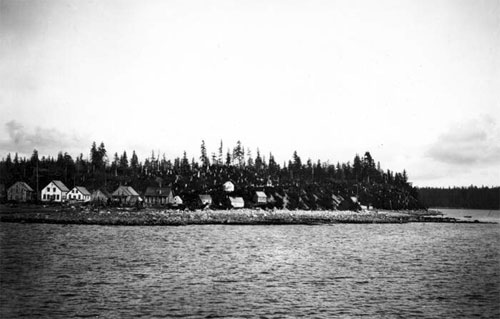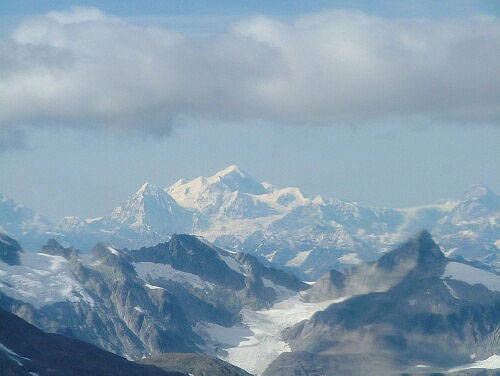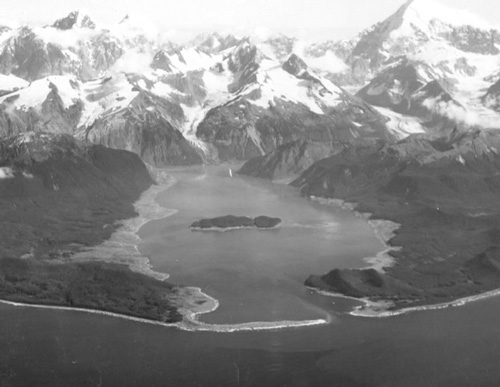
Miners Create “Justice System” In Order To Execute Accused Murderer By DAVE KIFFER September 26, 2011
Yet an example of frontier justice that happened more than a century ago, not far from Lituya Bay at the north end of the Panhandle, was unusual in the extreme. So much so that it inspired the famed writer Jack London to pen a short story based on it and continues to intrigue non-fiction and fiction authors.
Yakutat village, Yakutat Bay, 1899
The part of Alaska that stretches more than 500 miles from the Cross Sound to Cordova is one of the wildest parts of the continent with few Alaskans choosing to live there and even fewer choosing to visit. The Fairweather “grounds” 50 miles off the coast is one of the richest areas for salmon trollers and the Lituya Bay area has attracted numerous, unsuccessful, mining ventures over the years. The only community in the area is Yakutat, and it’s Mayor, Dave Stone, cheerfully calls it “the most isolated town in Alaska.” Physically, the area is cut off by both the often stormy Gulf of Alaska and by two high mountain ranges, including Mt. Fairweather (15,325 feet) and Mr. St. Elias (18,008 feet). Two of the largest glaciers in the world, the Malaspina and Bering, further isolate the narrow shoreline. Mt. Fairweather rises to its full height less than 15 miles from the coast, making it the tallest tidewater mountain in the world and further adding to the sense that the “Fairweather Country” is a very narrow toe-hold indeed. Even the areas where civilization could possibly get a toe-hold, such as Lituya Bay, come with their own challenges, not the least of which is brutal storms in the winter and summer. The entrance to Lituya Bay, the only significant harbor between Cross Sound and Yakutat, has dangerous shoals that have literally killed hundreds of sailors, both Native and Anglo, over the centuries. And even the calm waters of the bay itself have suffered some of the largest Tsunamis ever recorded. (see Surviving The Biggest Wave Ever, SITNEWS, July 8, 2008). But Alaskans, and other adventurers, seem to take a perverse pride in trying to make a go of it in the most inhospitable locales. And that brings us to the story of five such individuals, who came to Lituya Bay in search of riches and left with the strangest tale of frontier justice in Alaskan history.
Mount Fairweather taken from Glacier Bay, 2004
“(the prospectus) failed mention waves or drowning or earthquakes or, for that matter, anything questionable about the bay,” Fradkin wrote. “It was depicted as a wild Eden that could easily be tamed, where riches could be effortlessly plucked from the sands.” Fradkin noted that the prospectus also had testimonials from prominent people in the industry noting that while there had been no strike “yet” in the area, it was believed that individual miners could be expected to pull $40 a day or more from the claims. The company had some 1200 acres of mining claims in the area and a 160 acre town site had already been designated in the bay. “The climate was mild,” he wrote. “Timber, water, salmon, wild game and wild berries, enough of the latter to support a cannery, were plentiful. Potatoes, turnips, parsnips, radishes, lettuce and cabbage could easily be grown in the ‘naturally irrigated’ soil. There was no mention of winter.” Like many of the miners and hopeful miners on the west coast, the Nelsons were looking for the next big strike because both the Klondike and Nome gold strikes were already peaking. They jumped at the chance to help get the company’s operations off the ground and were joined by three other potential miners, Fragnalia Stefano, Sam Christiansen – or Christianson, accounts differ - and Martin Severts. The five were to work the company claims and then act as caretakers of the property over the winter of 1899-1900, according to Fradkin. Nelson was large Scandinavian miner who had a big sense of humor, according to Fradkin. He was a carpenter and had been a foreman on a previous mining crew. Juneau author Lynn Schooler, who’s 2010 book about the area is called “Walking Home,” wrote that Hannah Nelson was an Englishwoman who came to America in 1898 as a handmaiden to a wealthy lady on a grand tour of the continent. Hannah Butler met Hans Nelson in Chicago and eloped. Schooler wrote that the couple went to Skagway where the met the other three members of their group. Under the pen name of Lyn D’urso, Schooler has also written a novel called “Heartbroke Bay” based on the incident. It was also published in 2010 “It was hardscrabble mining in an exceedingly remote and rugged place, with little chance of a big strike that would make them rich,” Schooler wrote in “Walking Home”. “After months of hard labor, the five had only around $800 dollars worth of fine gold dust to show for their efforts.” The couple lived in a separate cabin from the other three miners, according to Fradkin, but they ate together in the Nelson’s cabin which was reportedly located next to the aptly-named Justice Creek, just north of the entrance to Lituya Bay.
Lituya Bay a few weeks after the 1958 tsunami. The areas of destroyed forest along the shorelines are clearly recognizable as the light areas rimming the bay. A fishing boat anchored in the cove at lower left was carried over the spit in the foreground; a boat under way near the entrance was sunk and a third boat, anchored near the lower right rode out the wave.
But a few minutes later Severts returned and leveled either a .45 caliber or .38 calibre (accounts differ) hand gun at Stefano and killed him instantly. Then he turned to fire at Christiansen, but the bullet struck a stone jar and then hit Christiansen in the neck. Although the incident was over in a few seconds, it left the miners in a quandary. How to do care for and also guard a wounded killer for the rest of the winter. Before the shooting, Severts had apparently packed his bags. They asked him if he had planned to kill the other prospectors for the $800 in gold they had accumulated. His answer was reportedly a non-committal “maybe.” They tried to hail a passing steamer to take Severts off their hands, but were unsuccessful. Then they hired some local Natives to guard him at a separate cabin. After a few weeks, the Indians grew tired of their task and refused to guard the prisoner. “Severts, suffering from his prolonged confinement and bondage, began to beg to be killed, but Hannah could not reconcile her Victorian belief in a civilized system of law and order with the urgent need to dispatch him,” Schooler wrote. “Although Severts wished to die, (Hannah preferred not to) give in to the tempting practicality of summary execution and mob justice.” Schooler wrote that the solution was a unique one. “At Severts’ request, the surviving miners – including the prisoner – held an election incorporating Lituya Bay as a community,” Schooler wrote. “They elected Hannah as community’s judge and Hans as a prosecutor. Hannah made careful handwritten notes of all the proceedings, as well as a transcript of the trial that followed. Two Indians were summoned from a nearby encampment to act as witnesses as Severts signed a confession stating that he intended to kill them all for the gold, then return to Juneau and blame the murders on the Indians.” Severts was then hanged from a tree at the north end of the La Chaussee Spit at the mouth of Lituya Bay. Fradkin says it was the recorded “lynching” in the history of Alaska. It was reported to the authorities the next time a vessel landed at the bay and the first outside notice of the event was in a May, 1900 issue of The (Sitka) Alaskan. “The Excelsior also reports a lynching bee at Lituya Bay,” the newspaper reported. “Two (sic) men were murdered there last fall and, it being impossible to communicate with the authorities at Sitka and fearing to set the murderer at large in the community, being satisfied of his guilt, the Lituyans thought it proper to take the law into their own hands, hence the elevation of the criminal.” Also in May of 1900, a slightly different story appeared in the Juneau Record Miner newspaper under the headline “Hanged At His Own Request.” “J.H. Nelson and his wife arrived on the Bertha from Lituya Bay and bring the report of the murder and hanging that took place there. Mr. Nelson, foreman of the Lituya Bay Mining Company, states that a miner named Martin Severts shot and killed Steve Fugido on the 26th of October last. Severts, the murderer, was hanged several days later at his own request by Indians who were guarding him. Mr. Nelson and his wife are stopping at the Franklin Hotel.” But the story didn’t die there. Christiansen went on to become a “popular beer wagon driver” in Juneau, according to Fradkin, and frequently told the tale of the shooting and lynching. The Nelsons were “exonerated” by a federal judge who called Hannah a “plucky little woman” in his report, according to Schooler, and eventually relocated to Atlin, British Columbia where they operated a general store for many years. Then they lived in Bellingham, Washington, according to Fradkin. Somehow, the story continued to make the rounds until it was picked up by the San Francisco Examiner, which published an account in its Sunday magazine early in 1906. The Examiner was part of William Randolph Hearst’s chain and was known to pump up the drama in stories in what was then referred to as “yellow journalism.” The headline of the Examiner story was “Woman Hangs a Man And the Law Upholds Her.” It was there that Jack London became acquainted with the story. The author of “Call of the Wild,” “White Fang” and “The Sea Wolf” changed the names of the protagonists and added a few fictional details. He called the story “The Unexpected,” which then first appeared in the McClure’s Magazine in August of 1906. He also wrote of the mental states of the protagonists, particularly noting that Hannah had been the chief force behind the trial and hanging, stepping in to kick away the barrel that the condemned man was standing on when her husband was unable to finish the hanging. “The trouble with the story, however is that it once more illustrates the adage that truth is stranger, and more plausible, than fiction,” author Franklin Walker wrote in his 2005 book, “Jack London and the Klondike.” “The actual event remains quite incredible, even if it really took place, and the story based on it suffers in comparison.” The “facts” in the London story were also called into question in a lengthy story by the Seattle Post Intelligencer in September of 1906, with its competitor, the Seattle Times, taking the opposite side of the argument a couple of days later. The (Sitka) Alaskan also chimed in with a story on Oct. 16, 1906, in which it interviewed Christiansen and gave his version of the events. “Severts himself begged to be killed and the Indians were present at the hanging,” The Alaskan quoted Christiansen. “We all did everything in our power to have Severts explain to us why he wished to kill us but he would never say… There had never been a cross word among us and it was the most unexpected thing in the world. His confession admits that it was his intention to kill us all, take the money, and then report that the Indians committed the crime.” In his 1986 book on Lituya Bay and the Fairweather Country, “Land of Ocean Mists,” Francis Caldwell wasn’t quite so certain about the ‘confession.’ “There is, quite clearly, a discrepancy in the matter of Severts’ ‘confession,’ but I am unable to clear it up and I doubt that it ever will be sorted out,” Caldwell wrote. “So far as I have discovered, it was the first violence at Lituya Bay during the mining days.” Later, Fradkin wrote, Hannah Nelson reportedly came to agree with the scenario that London had written. But Fradkin suggests that she just found it easier to go along with the story that many in the public already thought they knew.
On the Web:
Contact Dave at dave@sitnews.us
Publish A Letter in SitNews Read Letters/Opinions
|
||


